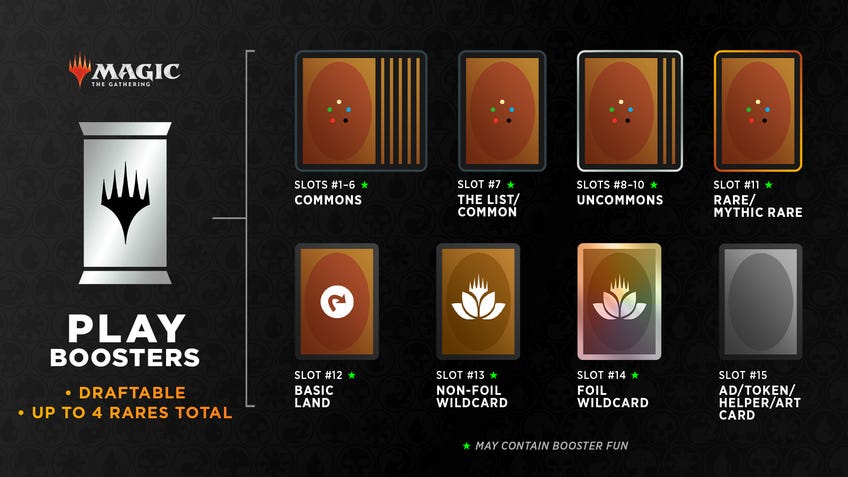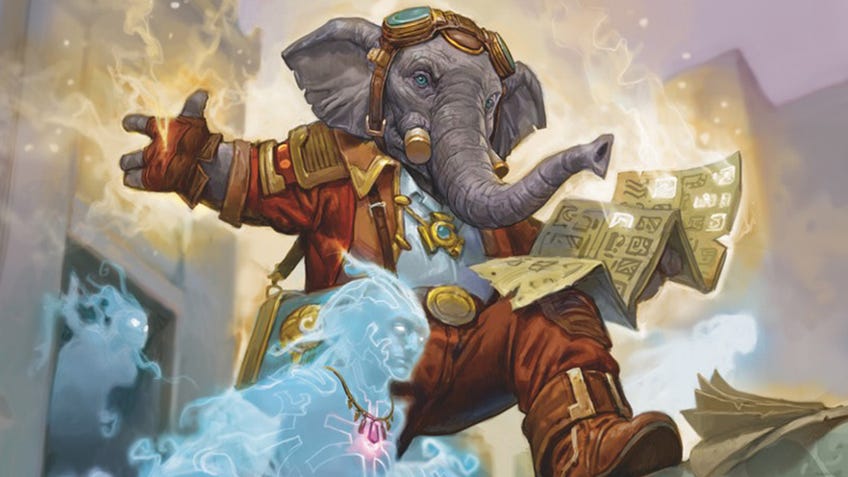Magic: The Gathering kills both draft and set boosters to create a unified product - the Play Booster
“Our goal was to combine the play experience of a Draft Booster with the fun opening experience of a Set Booster.”
Magic: The Gathering is once again revolutionising its lineup of booster pack offerings, but this one has nothing to do with overpriced whale-enticing cardboard. Instead, both set boosters and draft boosters will be alchemised into something they hope will capture the best of both worlds: the Play Booster.
Publisher Wizards of the Coast detailed what exactly players can expect from the upcoming Play Booster at a recent press event, hosted by communications director Blake Rasmussen and Senior Communications Manager Larry Frum. They were quick to point out that nothing would be changing with MTG’s Collector Boosters, and that this move sums up years of work and iteration from the R&D team. Rasmussen described Play Boosters as a collection of “relatively simple, clean changes,” though he paused slightly before adding that “of course, the devil is in the details.”
Beginning with Murders at Karlov Manor, a set currently planned to release in February 2024, Wizards of the Coast will produce a single booster pack meant to be used in limited formats (draft, sealed, etc.) and also cracked up by casual players hoping to pull a mythic rare or special treatment. The shift will hit every language market currently producing Magic: The Gathering cards, and 36-card booster box will be sold at the same suggested price as the current set booster box (roughly 20% more expensive than draft boosters).

Each Play Booster will contain 15 cards: six guaranteed common rarity followed by another common that has a chance to be replaced by something from The List, three guaranteed uncommons, one rare or mythic rare quality, a basic land, a non-foil wildcard (any rarity), a foil wildcard (any rarity) and finally a slot that can be an ad insert, token, helper card or art cards. These last were normally the sole purview of set boosters.
Here’s a quick summary of the differences between each currently available pack. When compared to Set Boosters, Play Boosters will have two more playable cards at the cost of a wildcard slot and the guaranteed art card. They also lose the “connected commons and uncommons” theming of cards, but internal polling apparently ranked that low on players’ desires. Compared to draft boosters, Play Boosters contain one less playable card and three less guaranteed commons but gain both a non-foil and foil wildcard slot (a majority accounting for the difference in rare card potential). Players may also pull a card from the list, which will be usable in limited formats.
Rasmussen pointed out that the Play Booster retains the possibility of pulling anywhere between one and four rares from each pack. This means no change for players who normally only purchase set boosters, but draft players will potentially be dealing with a lot more threats in the limited environment. Mark Rosewater’s article on the MTG mothership describes in detail how the design teams have accounted for this change by designing sets around the existence of Play Boosters in multiple ways - such as including more tools to deal with beefy creatures and limited bombs, but also raising the general floor of quality for commons in all sets.
Rosewater’s article begins by explaining Wizards of the Coast’s discovery that set boosters were inadvertently killing draft boosters and by extension harming a significant way people play MTG. The venerable trading card game originally split its single booster pack in two back in 2018 with Zendikar Rising (regular boosters were rebranded as draft booster a bit earlier), and casual players have gravitated towards the pack of cards that would contain more chances at fun alternate art and potentially valuable rares and mythic rares.
The result: draft boosters sitting on shelves or smaller hobby shops being forced to choose which of the two they can stock. Instead of forcing stores to choose between making money or fostering a local limited community, Wizards of the Coast seem confident the Play Booster will deliver a booster greater than the sum of its sacrificed parts.
“[We] realised the need for a change. The answer was simple, although the execution was complicated. We needed to return to a single type of core booster, what we dubbed the Play Booster,” Rosewater wrote. “Our goal was to combine the play experience of a Draft Booster with the fun opening experience of a Set Booster.”

